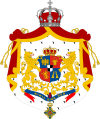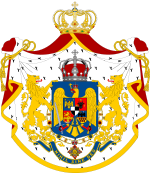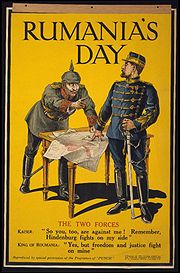Ferdinand of Romania
| Ferdinand | |
|---|---|
| King of the Romanians | |
 |
|
|
|
|
| Reign | 10 October [O.S. 27 September] 1914-20 July 1927 |
| Predecessor | Carol I |
| Successor | Michael |
| Spouse | Marie of Edinburgh |
| Issue | |
| Carol II of Romania Elisabeth, Queen of the Hellenes Maria, Queen of Yugoslavia Prince Nicholas Archduchess Ileana of Austria Prince Mircea |
|
| Full name | |
| Ferdinand Viktor Albert Meinrad of Hohenzollern | |
| House | House of Hohenzollern-Sigmaringen |
| Father | Prince Leopold of Hohenzollern-Sigmaringen |
| Mother | Antónia of Portugal and Kohary |
| Born | 24 August 1865 Sigmaringen, Germany |
| Died | 20 July 1927 (aged 61) Sinaia, Romania |
| Burial | Curtea de Argeş, Romania |
Ferdinand (24 August 1865 – 20 July 1927) was the King of the Romanians from 10 October 1914 until his death.
Contents |
Early life
Born in Sigmaringen in southwestern Germany, the Roman Catholic Prince Ferdinand Viktor Albert Meinrad of Hohenzollern-Sigmaringen, later simply of Hohenzollern, was a son of Prince Leopold of Hohenzollern-Sigmaringen and Infanta Antónia of Portugal (1845-1913), daughter of Queen Maria II and King Ferdinand II, a Prince of Saxe-Coburg and Gotha and heir to the Slovakian originated Hungarian magnates of Kohary on his mother's side.
Following the renunciations, first of his father (1880) and then of elder brother Prince Wilhelm of Hohenzollern-Sigmaringen, in 1886, young Ferdinand became the heir to the throne of his childless uncle, King Carol I of Romania - ? in November 1888. In 1889, the Romanian parliament recognized him as a prince of Romania. The Romanian government did not require his conversion to Eastern Orthodoxy from Catholicism, allowing him to continue with his born creed, but it was required that his children be raised Orthodox, then the state religion of Romania.
Ferdinand's mother's first cousin Tsar Ferdinand I of Bulgaria sat on the throne of the neighboring Bulgaria since 1889 and was to become the greatest opponent of the kingdom of his Romanian cousins. The neighboring Emperor Francis Joseph, monarch of Austria-Hungary and as such, ruler of Transylvania, a province with a clear ethnic Romanian majority, was Ferdinand's grandmother's first cousin.
His aunt, queen Elisabeth, plotted that he would marry Elena Vacarescu. This was sort of dynastical crisis, in 1891.
In Sigmaringen on 10 January 1893, Prince Ferdinand of Romania married his distant cousin, the Lutheran Princess Marie of Edinburgh, daughter of Anglican Prince Alfred, Duke of Edinburgh and the Orthodox Grand Duchess Marie Alexandrovna of Russia. Marie and Ferdinand were third cousins in descent from Franz Frederick Anton, Duke of Saxe-Coburg-Saalfeld. Marie's paternal grandparents were Victoria of the United Kingdom and Prince Albert of Saxe-Coburg-Gotha. Her maternal grandparents were Alexander II of Russia and Marie of Hesse and by Rhine. The reigning Emperor of the neighboring Russia was Marie's first cousin Tsar Nicholas II.
The marriage produced 3 sons (one of whom, Mircea, died in infancy) and 3 daughters. Ferdinand's wife was reportedly adulterous in later stages of the marriage, and thus Mircea is thought to have been the biological child of Prince Barbu Ştirbey. However, Ferdinand reportedly wanted to avoid any scandal, and accepted Mircea as his own son.
King of Romania
| Monarchical styles of King Ferdinand I of Romania |
|
|---|---|
  |
|
| Reference style | His Majesty |
| Spoken style | Your Majesty |
| Alternative style | Sir |
|
||||||||||||||||||||||||||||||
Ferdinand succeeded his uncle on the latter's death (Carol I died without surviving issue) as King of Romania on 10 October 1914, reigning until his own death on 20 July 1927.
He was the 1,174th Knight of the Order of the Golden Fleece in Austria in 1909 and the 868th Knight of the Order of the Garter in 1924.
World War I
Though a member of a cadet branch of Germany's ruling Hohenzollern imperial family, Ferdinand presided over his country's entry into World War I on the side of the Triple Entente powers against the Central Powers on 27 August 1916. Thus he gained the nickname the Loyal, respecting his oath when sworn in before the Romanian Parliament in 1914:
| “ | I will reign as a good Romanian. | ” |

As a consequence of this "betrayal" toward his German roots, Kaiser Wilhelm II had his name erased from the Hohenzollern House register.
Despite the setbacks after the entry into war, when Dobruja and Wallachia were occupied by the Central Powers, Romania fought in 1917 and stopped the German advance into Moldavia. When the Bolsheviks sued for peace in 1918, Romania was surrounded by the Central Powers and forced to conclude the Treaty of Bucharest, 1918. However, Ferdinand refused to sign the treaty. When the Allied advanced on the Thessaloniki front, they knocked Bulgaria out of the war, and Ferdinand ordered the re-mobilization of the Romanian Army, and Romania re-entered the war on the Triple Entente side.
The outcome of Romania's war effort was the union of Bessarabia, Bukovina and Transylvania with the Kingdom of Romania in 1918. Ferdinand became the ruler of a greatly enlarged Romanian state in 1918-1920 following the Entente's victory over the Central Powers, a war between the Kingdom of Romania and the Hungarian Soviet Republic, and the civil war in Russia, and was crowned King of Romania in a spectacular ceremony on 15 October 1922 at the historic princely seat of Alba Iulia, in Transylvania.
After the war
Domestic political life during his reign was dominated by the conservative National Liberal party led by the brothers Ion and Vintilă Brătianu. The acquisition of Transylvania ironically enlarged the electoral base of the opposition, whose principal parties united in January 1925-October 1926 to form the National Peasant Party.
Ferdinand died in Sinaia in 1927, and was succeeded by his grandson Michael I, under a regency. The regency had three members, one of whom was Ferdinand's second son, Prince Nicholas.
Ancestors
| Ancestors of Ferdinand of Romania | ||||||||||||||||||||||||||||||||||||||||||||||||||||||||||||||||||||||||||||||||||||||||||||||||||||||||||||||||||||||||||||||||||||||||||||||||||||||||||||||||||||||||||||||||||||||||||||||||||||||||||||||||||||||||||||||||||||||||||||||||||||||||||||||||||||||||||||||||||||||||||||||||||||||||||||||||||||||||||||||||||||||||||||||||||||||||||||||||||||||||||||||||||||||||||||||||||||||||||||||||||||||||||||||||||||||||||||||||||||||||||||||||||||||||||||||||||||||||||||||||||||||||||||||||||||||||||||||||||||||||||||||||||||||||||||||||||
|---|---|---|---|---|---|---|---|---|---|---|---|---|---|---|---|---|---|---|---|---|---|---|---|---|---|---|---|---|---|---|---|---|---|---|---|---|---|---|---|---|---|---|---|---|---|---|---|---|---|---|---|---|---|---|---|---|---|---|---|---|---|---|---|---|---|---|---|---|---|---|---|---|---|---|---|---|---|---|---|---|---|---|---|---|---|---|---|---|---|---|---|---|---|---|---|---|---|---|---|---|---|---|---|---|---|---|---|---|---|---|---|---|---|---|---|---|---|---|---|---|---|---|---|---|---|---|---|---|---|---|---|---|---|---|---|---|---|---|---|---|---|---|---|---|---|---|---|---|---|---|---|---|---|---|---|---|---|---|---|---|---|---|---|---|---|---|---|---|---|---|---|---|---|---|---|---|---|---|---|---|---|---|---|---|---|---|---|---|---|---|---|---|---|---|---|---|---|---|---|---|---|---|---|---|---|---|---|---|---|---|---|---|---|---|---|---|---|---|---|---|---|---|---|---|---|---|---|---|---|---|---|---|---|---|---|---|---|---|---|---|---|---|---|---|---|---|---|---|---|---|---|---|---|---|---|---|---|---|---|---|---|---|---|---|---|---|---|---|---|---|---|---|---|---|---|---|---|---|---|---|---|---|---|---|---|---|---|---|---|---|---|---|---|---|---|---|---|---|---|---|---|---|---|---|---|---|---|---|---|---|---|---|---|---|---|---|---|---|---|---|---|---|---|---|---|---|---|---|---|---|---|---|---|---|---|---|---|---|---|---|---|---|---|---|---|---|---|---|---|---|---|---|---|---|---|---|---|---|---|---|---|---|---|---|---|---|---|---|---|---|---|---|---|---|---|---|---|---|---|---|---|---|---|---|---|---|---|---|---|---|---|---|---|---|---|---|---|---|---|---|---|---|---|---|---|---|---|---|---|---|---|---|---|---|---|---|---|---|---|---|---|---|---|---|---|---|---|---|---|---|---|---|---|---|---|---|---|---|---|---|---|---|---|---|---|---|---|---|---|---|---|---|---|---|---|---|---|---|---|---|---|---|---|---|---|---|---|---|---|---|---|---|---|---|---|---|---|---|---|---|---|---|---|---|---|---|---|---|---|---|---|---|---|---|---|---|---|---|---|---|---|---|---|---|---|---|---|---|---|---|---|---|---|---|---|---|---|---|---|---|---|---|---|---|---|---|---|---|---|---|---|---|---|---|---|---|---|---|---|---|---|---|---|---|---|---|
|
||||||||||||||||||||||||||||||||||||||||||||||||||||||||||||||||||||||||||||||||||||||||||||||||||||||||||||||||||||||||||||||||||||||||||||||||||||||||||||||||||||||||||||||||||||||||||||||||||||||||||||||||||||||||||||||||||||||||||||||||||||||||||||||||||||||||||||||||||||||||||||||||||||||||||||||||||||||||||||||||||||||||||||||||||||||||||||||||||||||||||||||||||||||||||||||||||||||||||||||||||||||||||||||||||||||||||||||||||||||||||||||||||||||||||||||||||||||||||||||||||||||||||||||||||||||||||||||||||||||||||||||||||||||||||||||||||
Notes
References
- (Romanian) Wolbe, Eugen:Ferdinand I - Întemeietorul României Mari (Ferdinand I, founder of Greater Romania), Humanitas, 2006.
External links
 Media related to Ferdinand I of Romania at Wikimedia Commons
Media related to Ferdinand I of Romania at Wikimedia Commons- Royal House of Romania
- Princely House of Hohenzollern
- Ducal House of Saxe-Coburg-Gotha
- Royal House of Great Britain
- A short biography mainly about his role in WW1
|
Ferdinand of Romania
House of Hohenzollern-Sigmaringen
Cadet branch of the House of Hohenzollern
Born: 24 August 1865 Died: 20 July 1927 |
||
| Regnal titles | ||
|---|---|---|
| Preceded by Carol I |
King of Romania 1914-1927 |
Succeeded by Michael I |
|
||||||||||||||||||||